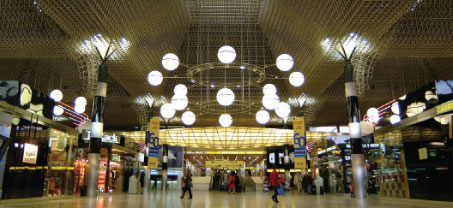
Following the construction of Lisbon Airport’s new Terminal 2 in 2007, the main Terminal 1 is now the focus of the ongoing development plan.
The development of Lisbon Airport – the busiest in Portugal having handled more than 14 million passengers in 2010 – is built upon four main goals: to increase capacity; to enhance operational and service levels; to improve non-aeronautical revenues; and to consolidate the airport’s existing position as a regional hub.
Over the course of the last decade, Lisbon Airport has experienced an average annual increase in passenger numbers of +7% and as it continues to be one of the fastest-growing airports in Europe, the facilities continue to be developed to allow for as many as 18 million passengers by 2017.
Following the construction of the new Terminal 2 in 2007 – which was built specifically for domestic services – Terminal 1 is now the focus of the development plan.
“The main Terminal 1 was freed up by the new building and the structure is in the process of being optimised,” explained ANA Aeroportos de Portugal’s Rui Oliveira. “Along with new parking areas, there will be a new north pier and a new north bus gate, both attached to the main terminal. New cargo facilities, a new fuel farm, a renovated baggage claim area and a metro station are also planned.”
Once the plan is complete, the airport will be at maximum capacity with 40-42 movements per hour and no room for further expansion, due to the surrounding urban environment.
ANA’s focus on developing non-aeronautical revenues pays special regard to retail and ancillary revenues due to their important role in both the overall passenger service that is offered and the sustainable development of the airport.
Oliveira said: “Airports must understand the needs of their airline partners and develop new business models that bring a profitable future for all parties. All of this work culminates in the fourth goal, which is the consolidation of the airport’s position as a regional hub. Despite the difficulties involved in optimising a space-constrained hub, the airport’s status has to be maintained, if not enhanced.”
Developing the portfolio
As well as the development of Lisbon Airport, ANA is also committed to developing the six other airports under its stewardship, and the Faro Airport Development Plan is currently being implemented at Portugal’s second-busiest airport.
The Development Plan will see a total investment of €30 million, with €6 million being granted by the Trans-European Transport Network (TEN-T). While the airport handled more than five million passengers in 2010, the project will allow for a significant increase in the passenger processing capacity, as well as an increase in service quality thanks to the addition of new boarding gates and rapid runway exits. The investment will also allow the airport to reach 100% safety compliance with ICAO Annex 14. All airports in the ANA group are currently Airport Carbon Accredited and ANA’s dedication to environmental efficiency is also evident in each of the development projects and this commitment was recently recognised by the ‘Most Efficient Company’ award at the first Energy Efficiency Awards in Portugal. The PremiValor Consulting initiative was supported by energy agency ADENE and the Directorate General for Energy and Geology (DGEG), and the study covered the 2,500 largest companies in the country.
As the facilities and processing capacities are increased via the ongoing investment, developing the existing route network also remains a top priority for ANA. Co-financed by Lisbon Airport, the Lisbon Tourism Association and the Portuguese Tourism Bureau, the €17 million Route Development Fund has been established for the next five years, while all airports have also implemented a Performance Reward System to assist airline customers in exploring new route opportunities.







